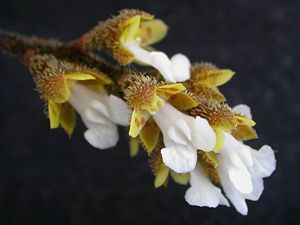Orchid/Catalogs/Taxonomy
| The metadata subpage is missing. You can start it via filling in this form or by following the instructions that come up after clicking on the [show] link to the right. | |||
|---|---|---|---|
|

Saundersia paniculata
This little genus of two species is a good example of a decision to be made by taxonomists in the future. It is currently classified under Oncidiinae among a group of small genera to be better placed. A recent publication by taxonomists of Florida University reveals that Saundersia belongs to an early diverted group which encompasses the genus Trichocentrum. Some species previously classified under Oncidium have been merged within the genus Trichocentrum in 2001. This move still is not consensual in 2009. Merging a genus that morphologically differentas Saundersia into it will make even harder to reach consensus. Some taxonomists propose the split of Tricocentrum in five genera, other would have all as subgenera of it.
The intent of this page is to explain the options regarding orchid taxonomy as it is presented on the Citizendium.
Present situation
Among the first questions someone who just started growing orchids asks is why taxonomists are changing their names so frequently lately. This is a good question, however, the impression taxonomists are changing their names only recently is a mistake. They ever had. Since Linnaeus set the rules of taxonomy, orchids names have constantly changed as they are better understood. During the last decade a high number of genera, which where classified provisionally under particular tribes and subtribes, finally found their true places, however, consensus is not always easily achieved or yet, on many cases, has to be.
The main problem orchid taxonomy currently faces is that, despite all taxonomists agree with the importance of phylogeny, some place it over all other methods of classifying a species, while other claim it is a good tool but still need to be improved, so it is too soon to change the whole system. Yet there is an additional problem: There is more than one way to split a cladogram. You may lump a large number of species together in a genus or split them minutely in several genera and both systems will contemplate phylogeny requirements.
Either because phylogenists get conflicting results when trying to split the species minutely in a cladogram, or because they believe having larger genera is better, they tent to propose large genera. Taxonomists which believe species should reflect morphology thus being more utile for species classification by growers and collectors, tent do split the genera more minutely. Many of these proposals are very new and it is not possible to know what will be the final choice of scientific community.
Choices available
Genera
The purpose of an encyclopedia is presenting information from a neutral point of view but as much neutral as one can be, some decisions have to be made about how to name a genus article. Four cases arise:
- The name is widely accepted so now doubt stands.
- The name is generally accepted but there are other points of view so the name is not absolutely settled. This should be mentioned on taxonomic section of the article.
- The name is under great dispute. In this case lack of consensus should be mentioned early, on the article introduction.
- A new classification has just been proposed and there is no general feedback about it as yet. In this case possibly it may be mentioned in the taxonomic section as a recent proposal of classification.
Species
The species acceptance varies a great deal form author to author. It is common that specialists in a particular genus split their species more minutely than the general taxonomists. We suggest the linear adoption of The World Checklist of Monocotyledons choices and explain the other available classification choices on species discussion.
Taxonomy followed here
General taxonomy
As there is no international institution regulating the choices of orchid names but only their descriptions validity, it is suggested that The World Checklist of Monocotyledons may be a good starting point regarding the names to choose. The remark on fully following this list is that it is managed by the group of taxonomists which place phylogeny information above all other so sometimes it may not reflect the lack of consensus. A second remark is that it is not updated on daily bases and several general may be two years outdated.
The general adoption of the taxonomy on Genera Orchiacearum Series published by Oxford University is generally followed here. Although not fully because as this series have started to be published in 1999, some more recent information has came out ever since. Moreover, about half of Epidendroideae subfamily genera are to be published as yet.
Particular cases and exceptions
Some genera are object of passionate disputes and decisions regarding their presentation yet need to be fully detailed (provisional suggestions are under brackets).
- Maxillaria (follow Florida University team)
- Dendrobium (follow Clements and Jones)
- Oncidium group (follow V.P.Castro, Chiron, Campacci, Baptista and Docha Neto)
- Pleurothallis group (follow Luer)
- Masdevallia (follow Luer)
- Calanthe (follow Clements and Jones)
- Eria (yet to be fully published)
- Habenaria (yet to be fully published, possibly follow Szlachetko)
- Cattleya group (follow V.P.Castro, Chiron & Campacci)
- Trichocentrum (follow Braem & Christenson)
Orchidaceae Taxonomy
The full list of orchid subfamilies, genera, and its intermediate rankings is:
